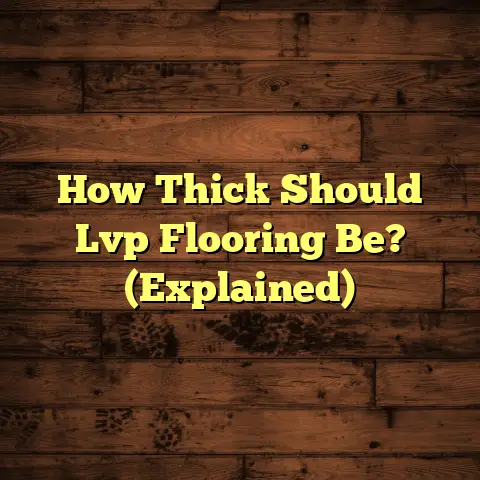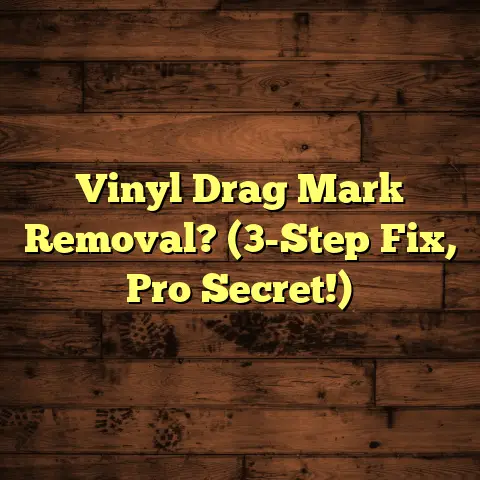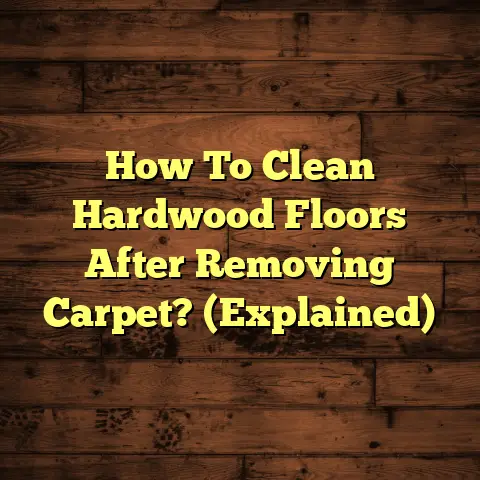Laminate Flooring Price In Singapore? (3 Key Mistakes)
Understanding the Impact of 3 Key Mistakes on Resale Value
Ever wondered how much that new flooring impacts your home’s value?In Singapore, where property is a hot topic, every detail counts, especially when it comes to resale.
Laminate flooring has become super popular, offering a wallet-friendly and stylish option.
But here’s the thing: not all laminate is created equal, and making the wrong choices can seriously dent your resale value.
As a flooring contractor with years of experience in Singapore, I’ve seen it all. Homeowners trying to save a buck only to lose thousands later when selling their property.
So, I’m going to walk you through the three biggest mistakes I see people make with laminate flooring that can kill your resale value.
We’ll cover everything from quality to trends to installation. Trust me, this is info you don’t want to miss!
The Importance of Resale Value in
Home Renovations
Okay, let’s dive into why resale value is so crucial here in Singapore. It’s not just about selling your place for a profit; it’s about making smart investments.
Think of your home as a long-term savings account. You want it to grow, right?
In Singapore’s competitive real estate market, resale value is the golden key. It’s what determines how much you get back when you decide to sell.
Factors like location, nearby amenities, and the overall market situation all play a role. But one thing that homeowners often overlook is the condition of the property itself.
And that’s where flooring comes in.
Flooring is one of the first things potential buyers notice when they walk into a home. It sets the tone, influences their perception of quality, and impacts their willingness to make an offer.
Laminate flooring, in particular, has become a go-to choice for many Singaporean homeowners because it offers a balance of affordability and style.
But here’s the kicker: choosing the wrong laminate can actually decrease your home’s appeal.
I’ve seen it happen countless times.
A homeowner renovates with cheap laminate to save money, only to find that buyers are turned off by its poor quality or outdated style.
This leads to lower offers, longer time on the market, and ultimately, a significant financial loss.
Let’s talk numbers.
According to a recent study by a local real estate firm, homes with updated, high-quality flooring can command up to a 5-10% higher resale price compared to similar properties with outdated or damaged floors.
That’s a huge difference!
For example, if you’re selling a condo worth $1 million, a 5% increase translates to an extra $50,000 in your pocket.
And trust me, that’s money worth investing in the right flooring.
I remember one client who decided to upgrade their old, worn-out parquet flooring with high-end laminate.
They chose a stylish, modern design that complemented the rest of their home’s decor.
When they put their property on the market, they received multiple offers within the first week, and ultimately sold it for $70,000 more than they had expected.
They attributed much of their success to the updated flooring, which created a positive first impression and made their home stand out from the competition.
So, keep in mind, flooring is not just a functional element; it’s a key factor that can significantly enhance or diminish your property’s appeal and resale value.
Mistake #1 – Choosing Low-Quality Laminate
Alright, let’s get into the first big mistake I see homeowners make: opting for low-quality laminate flooring to save on initial costs.
I get it. Renovations can be expensive, and it’s tempting to cut corners wherever you can. But trust me, this is one area where you don’t want to skimp.
Low-quality laminate might seem like a good deal at first. It’s cheaper, easier to find, and promises the same look as higher-end options.
But here’s the truth: it’s a ticking time bomb.
These cheaper laminates are often made with inferior materials that are less durable and more prone to damage.
Think about it: your floors take a beating every day. Foot traffic, spills, furniture, pets – they all take their toll.
Low-quality laminate simply can’t withstand the wear and tear of daily life.
Here are some of the long-term consequences you might face:
- Scratches and Dents: Low-quality laminate is easily scratched and dented, especially by sharp objects or heavy furniture.
- Water Damage: Cheaper laminates are more susceptible to water damage, which can cause warping, swelling, and even mold growth.
- Fading: Exposure to sunlight can cause low-quality laminate to fade over time, leaving your floors looking dull and lifeless.
- Peeling: The top layer of low-quality laminate can peel off, revealing the unsightly material underneath.
- Short Lifespan: Overall, low-quality laminate simply doesn’t last as long as higher- end options. You might find yourself replacing it much sooner than you expected.
And here’s the real kicker: potential buyers can spot low-quality laminate a mile away.
They’ll notice the scratches, the dents, the fading, and the overall cheap feel of the floor.
This can create a negative impression and lead them to question the overall quality of your home.
They might think, “If they skimped on the flooring, what else did they cut corners on?”
This can lead to lower offers or even deter buyers altogether.
On the other hand, investing in high-quality laminate can significantly boost your resale value.
High-quality laminates are more durable, water- resistant, and visually appealing.
They can withstand the rigors of daily life and maintain their appearance for years to come.
They also come in a wider range of styles and designs, allowing you to choose a look that complements your home’s overall aesthetic.
I had another client who was torn between installing cheap laminate and investing in a higher-quality option.
They were on a tight budget and thought they could save money by going with the cheaper choice.
I advised them to reconsider, explaining the potential long-term consequences and the impact on their resale value.
They eventually decided to invest in high-quality laminate, and they were thrilled with the results.
Their new floors looked stunning, and they received numerous compliments from friends and family.
When they eventually sold their property, they received a higher offer than they had anticipated, and they were convinced that the upgraded flooring played a significant role.
So, don’t fall into the trap of choosing low- quality laminate to save on initial costs. It’s a short-sighted decision that can ultimately cost you more in the long run.
Invest in high-quality laminate, and you’ll not only enjoy beautiful, durable floors, but you’ll also boost your home’s resale value.
Mistake #2 – Ignoring Market Trends
Okay, let’s move on to the second big mistake I see homeowners make: ignoring current market trends when selecting laminate flooring.
Just like fashion, interior design trends come and go. What was popular a few years ago might be completely outdated today.
And when it comes to flooring, staying up-to-date with market trends is crucial for maximizing your resale value.
Imagine walking into a home with bright orange laminate flooring.
Unless you’re a huge fan of the color orange, you’d probably be turned off, right?
That’s because the flooring doesn’t align with current design trends.
Buyers today are looking for homes that are stylish, modern, and move-in ready.
They want spaces that reflect their personal taste and lifestyle.
And if your flooring is outdated or doesn’t match the overall aesthetic of the home, it can create a negative impression.
It can make your home feel old, tired, and in need of renovation.
This can lead to lower offers or even deter buyers altogether.
So, how do you stay up-to-date with current market trends?
Here are a few tips:
- Read Interior Design Blogs and Magazines: These publications are a great source of inspiration and information about the latest design trends.
- Browse Online Platforms: Websites like Pinterest, Instagram, and Houzz are filled with images of stylish homes and trendy flooring options.
- Visit Showrooms and Model Homes: Visiting flooring showrooms and model homes can give you a firsthand look at the latest styles and designs.
- Consult with a Professional: A flooring contractor or interior designer can provide expert advice and guidance on choosing flooring that aligns with current market trends.
In Singapore, some of the popular flooring trends include:
- Light Wood Tones: Light wood tones like oak and maple are popular choices because they create a bright, airy, and modern feel.
- Wide Plank Flooring: Wide plank flooring is another popular trend that can make a room feel larger and more spacious.
- Grey Tones: Grey flooring has been trending for several years, and it’s still a popular choice for homeowners who want a sophisticated and contemporary look.
- Waterproof Laminate: With Singapore’s humid climate, waterproof laminate is becoming increasingly popular. It’s resistant to water damage and can withstand the rigors of daily life.
Choosing laminate that is out of style can be a huge turnoff for potential buyers.
For instance, remember those glossy, dark- colored laminates that were popular in the early 2000s?
They’re now considered outdated and can make a home feel dark and cramped.
I spoke with a real estate agent recently who said that homes with outdated flooring often sit on the market for longer and sell for less than comparable properties with updated flooring.
“Buyers want homes that are move-in ready,” she said. “They don’t want to have to spend time and money renovating the floors.”
I had a client who wanted to install dark, cherry-colored laminate in their home.
I advised them against it, explaining that it was an outdated style and wouldn’t appeal to most buyers.
They were hesitant at first, but they eventually decided to trust my advice and chose a light, neutral-toned laminate instead.
When they put their property on the market, they received multiple offers within the first week, and they were convinced that the updated flooring played a significant role in their success.
So, don’t make the mistake of ignoring market trends when selecting laminate flooring.
Stay up-to-date with the latest styles and designs, and choose flooring that will appeal to potential buyers.
It’s an investment that can pay off big time when it comes time to sell your property.
Mistake #3 – Improper Installation Techniques
Alright, let’s talk about the third and final big mistake I see homeowners make: poor installation practices that compromise the integrity and appearance of laminate flooring.
You might think that installing laminate flooring is a simple DIY project, but trust me, it’s not.
Proper installation requires skill, experience, and the right tools.
And if you don’t get it right, you can end up with a host of problems that can detract from your home’s value.
Improper installation can lead to issues such as:
- Warping: If the subfloor is uneven or not properly prepared, the laminate flooring can warp over time.
- Gaps: Gaps between the planks can create an unsightly appearance and allow dirt and moisture to accumulate.
- Uneven Surfaces: If the planks are not properly aligned, the flooring can feel uneven and uncomfortable to walk on.
- Squeaking: Improper installation can cause the flooring to squeak when you walk on it, which can be annoying and distracting.
- Damage to the Locking System: The locking system that holds the planks together can be damaged during installation, which can weaken the flooring and make it more susceptible to damage.
These issues not only detract from the appearance of your home, but they can also lead to more serious problems down the road, such as water damage and mold growth.
And here’s the thing: potential buyers can spot these problems a mile away.
They’ll notice the warping, the gaps, the uneven surfaces, and the squeaking.
This can create a negative impression and lead them to question the overall quality of your home.
They might think, “If they didn’t even bother to install the flooring properly, what else did they neglect?”
This can lead to lower offers or even deter buyers altogether.
That’s why it’s so important to hire qualified professionals for installation.
A professional installer has the skill, experience, and tools to ensure that your laminate flooring is installed correctly.
They’ll properly prepare the subfloor, carefully align the planks, and ensure that the locking system is properly engaged.
This will result in a beautiful, durable floor that will last for years to come.
I had a client who tried to save money by installing laminate flooring themselves.
They watched a few YouTube videos and thought they had it all figured out.
But they quickly ran into problems.
The subfloor was uneven, the planks weren’t aligning properly, and the locking system kept breaking.
They ended up with a warped, gappy, and uneven floor that looked terrible.
They eventually had to hire a professional to tear out the old flooring and install new flooring correctly.
They ended up spending more money than they would have if they had hired a professional in the first place.
I remember another client who hired a budget installer to save money.
The installer did a rushed job, and the flooring started to warp and squeak within a few months.
The client was furious and demanded that the installer fix the problems.
But the installer refused, claiming that the problems were due to the quality of the flooring, not the installation.
The client ended up having to hire another installer to fix the problems, which cost them even more money.
So, don’t make the mistake of trying to save money by hiring an unqualified installer or attempting to install laminate flooring yourself.
It’s an investment that can pay off big time when it comes time to sell your property.
Conclusion
Alright, let’s wrap things up.
As we’ve discussed, laminate flooring can be a fantastic choice for homeowners in Singapore, offering a cost-effective and stylish way to upgrade your home.
But it’s crucial to make informed decisions to avoid the three key mistakes that can negatively impact your resale value.
First, don’t skimp on quality.
Investing in high-quality laminate is essential for durability, aesthetics, and long-term value.
Low-quality laminate might save you money upfront, but it can lead to costly problems down the road and detract from your home’s appeal.
Second, stay up-to-date with market trends.
Choosing flooring that aligns with current styles and designs is crucial for attracting potential buyers.
Outdated flooring can make your home feel old and tired, leading to lower offers or even deterring buyers altogether.
Finally, hire qualified professionals for installation.
Proper installation is essential for ensuring the integrity and appearance of your laminate flooring.
Improper installation can lead to warping, gaps, uneven surfaces, and other problems that can detract from your home’s value.
By avoiding these three mistakes, you can ensure that your laminate flooring enhances your home’s appeal and boosts its resale value.
Remember, your home is one of your biggest investments.
Making smart decisions about flooring can pay off big time when it comes time to sell.
So, take the time to research your options, consult with professionals, and choose flooring that will not only look beautiful but also add value to your property.
In the long run, investing in quality flooring and understanding market trends is a smart decision that can help you achieve your financial goals.
Good luck with your flooring project!





